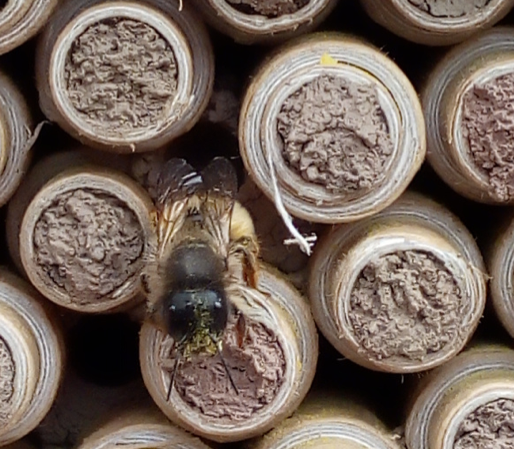By Athayde Tonhasca
We hear a lot about the pollination services provided by the European honey bee (Apis mellifera), so you may be surprised to know this bee is not that competent at its job. A honey bee moistens the pollen she collects and carries it tightly packed on her corbicula, or pollen baskets, so pollen grains are not easily dislodged when the bee visits another flower. Moreover, honey bees learn quickly to collect nectar with minimal contact with the flower’s anthers, so reducing the chances of pollen transfer. They are also good at flower constancy (the trait of visiting the same type of flower over and over), which is not good for plants that need cross-pollination between different varieties, such as apples. Thus, paradoxically, honey bees’ efficiency as food collectors reduces their efficiency as pollinators. These shortcomings are offset by the huge numbers of bee workers per hive and the fact that they are so amenable to management.
In comparison with the tidy honey bee, the red mason bee (Osmia bicornis) is a messy flower visitor. Females have low flower constancy, flying all over the place, and carry dry pollen loosely attached to their scopa (a mass of hairs under the abdomen). This means that pollen grains have a greater chance of becoming detached from the bees’ bodies and ending up on a flower’s stigma.

What’s more, the red mason is one the most polylectic bees in Europe, that is, it collects pollen from a variety of flowers from unrelated species: 18 plant families altogether, including willows (Salix spp.), maples (Acer spp.), birch (Betula spp.), oaks (Quercus spp.) and several fruit trees in the family Rosaceae such as apples, pears, plums, cherries and peaches. Unsurprisingly, this bee is an excellent orchard pollinator; 500 or so female red masons can pollinate as many trees as 2-4 honey bee colonies.
Like other Osmia species, the red mason is a cavity-nesting bee; it makes itself at home in preexisting holes and fissures in soil banks or dead wood, abandoned insect burrows, hollow stems, or cracks and holes in walls – which explains the common name, ‘the mason bee’. It may also excavate soft mortar, hence the reason for another common name: ‘the mortar bee.’ The red mason readily occupies man-made structures such as ventilation bricks, the space beneath roof tiles, even inside door locks. So this bee is the most likely tenant of bee houses.
Once a female occupies a cavity, she will construct a series of compartments (brood cells) and stock them with pollen as food for her offspring. She will then close the nest entrance with a mud plug. But she’s not done once the nest is finished: if conditions are right, she may build another six nests before the season is over. The larvae will eat the pollen and emerge as adults the following year to start the cycle again. See red mason bees in action here.

Mason bees tend to nest close to each other in aggregations of 50 to 250 females. And they are diligent pollinators, as demonstrated by these facts and figures:
- A female bee may construct 16 cells per nest, 1 cell/day.
- She will fly 300-400 m on average, up to 600 m, in search of flowers.
- Nineteen foraging trips are needed to collect the pollen and nectar for each cell.
- Her pollen load weighs 100-250 mg, up to 300 mg.
- She may visit 75 flowers each trip, up to 25 flowers/min, and she will stock up each cell in about 3.5 h.
- A cell with an egg that will develop into a female bee may contain 8 million grains of pollen. Fewer for male bees (they need less food): 4.6 million.
This hardworking bee is good news for wild flowers, and also for crop production. The red mason is an effective pollinator of rapeseed oil and a number of crops grown under polytunnels and glasshouses, such as strawberries and raspberries. Other mason bees have been managed as orchard pollinators in Japan and USA for many years; there is growing evidence that the red mason can play a similar role in orchards in Britain and other European countries.

The red mason bee is common throughout most of the UK from late March to June/July. During this short time as an imago (the adult stage), this bee will contribute to the pollination of countless wild flowers, crops and fruit trees. The red mason bee deserves to share the spotlight with the honey bee.
